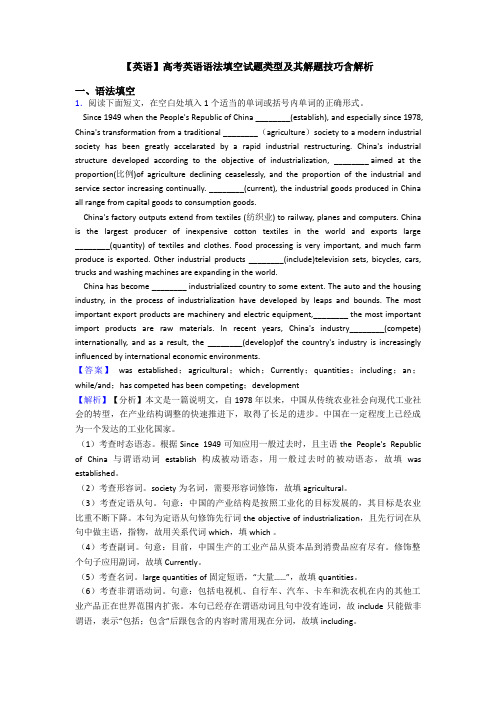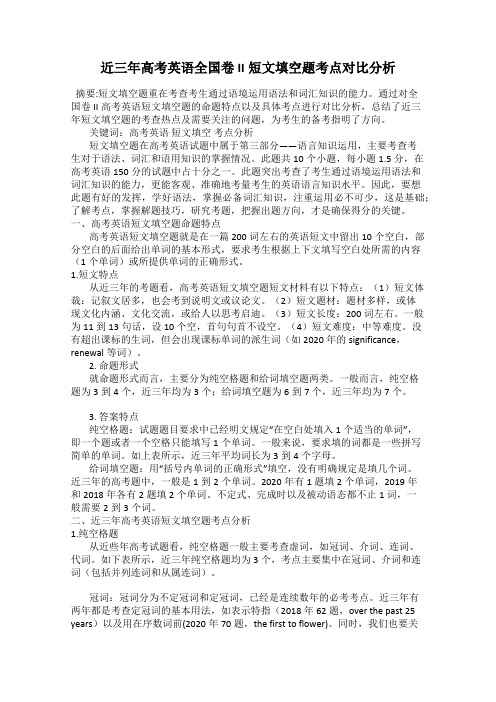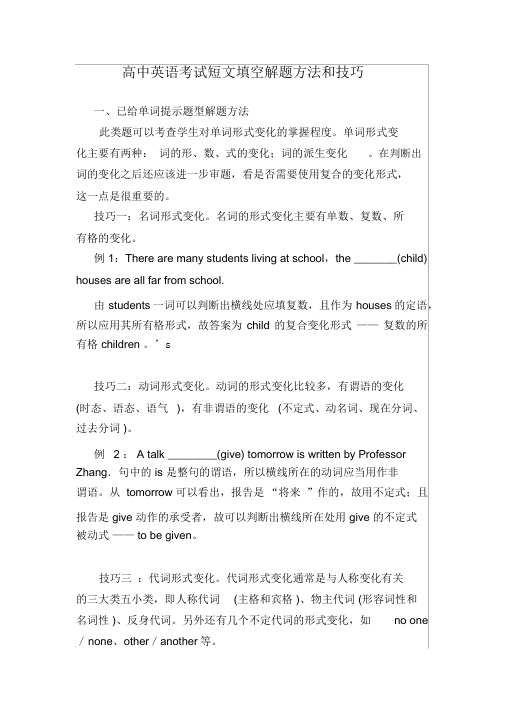高考英语 短文填词(选词填空)真题特色题型分类讲解
(考前添分指导)高考英语 短文填词指导(精讲精析)

定额市鞍钢阳光实验学校短文填词专项解读以来,高考英语(福建卷)第二卷第四部分“写作”的第一节为“短文填词”,共设10小题,每小题1分,满分10分,要求考生阅读一篇短文并根据汉语提示、首字母提示或语境提示,在每个空格内填入一个适当的英语单词,并将该词完整地写在右边相对应的横线上,所填单词要求意义准确、拼写正确。
一、再现真题,感悟考点。
(一) 请完成以下三篇短文填词。
(1) 2013(福建卷)短文填词Every individual is a member of a group called the community, and it is the duty of every citizen ask what he can do for his community.76.A good citizen (相信) that he should serve the77.community and not the community serve h . As students,78.there are many ways in you can serve the community.79.Above all, however, you have to acquire a certain amount ofskill and experience b you can be of service to others.80.Your school has lots of (活动) which prepare you81. good citizenship. Many school societies train students82.to become good citizens who later p in volunteer work83.and serve the public in t of need. If you serve your community,84.you will grow to be a good citizen with a strong sense of85.responsibility.(2) 2012(福建卷)短文填词People often don’t do what they really want to for fear offailure. You don’t apply for a job case you don’t get it.76.You don’t perform at the school concert b others might77.laugh at you. A lack of confidence can l to a lot of78.suffering. The key to o this problem is to believe in79.yourself. This might be (容易) said than done, but there80.are many w to help you do this. Talk about your problem81.with a friend or look advice on the Internet. Imagine 82.yourself being (成功) and practice breathing techniques 83.to keep you calm when you get nervous. And the important 84.thing is: believe you can do it. When you’ve (学会) to do 85.that, you are well on your way. (3) 2011(福建卷)短文填词Sport is necessary for everyone. It helps you keep fit. Fitness isi if you want to be healthy throughout your life. The best 76.way to keep fit is to get plenty exercise by doing sport. 77.According to (科学家), doing sport can benefit 78. people a lot mentally as well as physically. The sport 79.they do, the happier they will f . Besides, sport can help 80.people develop will and determination. These qualities help people achieve their goals b they will not give up so easily when 81.(面对) difficulties. What’s more, sport builds team spirit, 82.which is good for the whole society. It helps people work (密切) 83.and smoothly and think about , not just themselves. 84.In c , sport is good for your health and happiness, and 85. for society.(二) 请核对答案并将自己的答案与正确答案备注。
高考英语第二轮复习专题短文填词解读与专练

毛额市鹌鹑阳光实验学校2009高考英语第二轮复习专题高考英语新题型——“短文填词”解读与专练一、新题型说明根据高中新课程关于“试题应增加语境设置,适当增加主观题”的要求,在新题型设计时首先考虑增加语境设置的主观题。
1. 本题采用短文填词的形式,替换试卷中原短文改错题,设题思路、方法、要求如下:重点考查单词拼写、语言基础知识、语篇理解能力和语言表达能力;在考查词汇的同时也考查学生读与写的能力。
考生必须在理解短文内容的基础上,把握短文主旨大意,运用所学语言知识填空,使短文语篇完整。
2. 题目选材符合学生的书面表达水平,短文词数在130左右,共设10小题,第一行不设题,其余每行挖空一处设一题;考查以实词为主,兼顾其他词性。
3. 每个空格根据提示用一个单词的适当形式填空,提示的方式有:汉语提示、首字母提示、语境提示,其中汉语提示、首字母提示各3~4个,语境提示2~4个。
4. 设题尽可能做到答案的唯一性。
如果出现与答案不同,但符合题目要求的答案也可以接受,具体由阅卷点裁定。
每个空格只能填入一个答案,超过一个的,该小题以零分计。
题例:短文填词(共10小题,每小题1分,满分10分)阅读下面短文,根据以下要求:1)汉语提示;2)首字母提示;3)语境提示,在每个空格内填入一个适当的英语单词,并将该词完整地写在右边相对应的横线上。
所填单词要求意义准确、拼写正确。
Last week, we talked about different kinds of short stories. Many of you said you liked the _______(的) writer Earnest76. ofHemingway, who is w known for short stories. I hope you77. wellall f my advice and finished reading his story. W e’re going78. followedto study it together in today’s lesson. Now since you79. aresupposed to have read this story, let’s have some (讨论).80. discussionPlease look at the three q______ on the blackboard. First, when81. questionand where does the story __ place? Second, what kind of82. takeperson does he show __ (自己) to be? Third, what is the83. himselfwriter’s main purpose of __ (写) the story? I’d like you to84. writingwork ______ pairs and present your answers in ten minutes. I hope85. in_______you can perform well enough.该题考查考生在语篇中综合运用英语语法、词汇及正确拼写单词的能力。
高考英语选词填空题解题技巧点拨

一、词性分类。
在单词旁边按名词、动词、形容词、副词标出 词性。这样学生在面对某一个空格时,只要根 据上下文的语法结构或逻辑关系不再是从10个 词中去选1个答案了,可以是4选1甚至2选1, 从而缩小了选择的范围,提高做题的准确率。 我们以09年上海卷选词填空题为例将选项按词 性分类:
2. 如何确定空格为动词。
(1)空格前面已经有主语,后面又有宾语, 空格处应填及物动词。
Realizing that the concept appears to be a real money-maker, Mr. Gignac has __47__ a company and is employing his girlfriend as vice president. He __48__ to discuss his profit margins: “It’s actually quite a lot of effort putting them together—but yes, garbage is free.” (09上海卷)
分类时要注意两点:
1. 有的单词不只有一个词性,如influence, heat, concern等。08年上海卷选词填空题中的 set 既有名词词性又有动词词性。这时两个都 要标出来。
2. 以-ing或-ed 结尾的词既可能是动词,也可能 是由现在分词或过去分词转变而成的形容词。 例如: sleeping在She is sleeping.中是动词,而 在a sleeping car中是形容词。
高三英语高考热点题型短文填词解题思路

现吨市安达阳光实验学校高考英语热点:题型“短文填词”解题思路一、题型说明1. 形式:替换试卷短文改错题,考查单词拼写、语言基础知识、语篇理解能力和语言表达能力;在考查词汇的同时也考查学生读与写的能力。
考生必须在理解短文内容的基础上,把握短文主旨大意,运用所学语言知识填空,使短文语篇完整。
2. 选材:符合学生的书面表达水平,短文词数在130左右,共设10小题,第一行不设题,其余每行挖空一处设一题;考查以实词为主,兼顾其他词性。
3. 提示方式:有首字母提示、汉语提示、语境提示,其中首字母提示、汉语提示各3~4个,语境提示2~3个。
每个空格根据提示用一个单词的适当形式填空。
4. 答案的唯一性。
如果出现与答案不同,但符合题目要求的答案也可以接受,具体由阅卷点裁。
每个空格只能填入一个答案,超过一个的,该小题以零分计。
短文填词共10小题,每小题1分,满分10分二、短文填词题八大考点1、名词:可数、不可数,可数名词的单复数形式;特别容易忽略名词的单复数,知道了名词的单复数,有时特别容易拼错,尤其是一些可数名词单复数的特殊变化,以及动名词之间的转换;如:leaf—leave; medium—media; advise—advice, practise—practice; succeed—success;2、动词:时态、语态、非谓语及动词形式的不规则变化;broadcast(broadcast, broadcast)广播 equip(equipped, equipping)装备注意:quarrel, signal, travel中的l可双写(英国英语)也可不双写(英语)3、形容词、副词:形容词与副词的区别(也可能考比较级及最);Simple—simply, fish—fisherman,possible—possibly 可能的, practical—practically 实际的4、数词:主要考序数词。
容易拼错的序数词,如:1. twenty—twentieth,2. ninth第九3. forty4. twelfth第十二5、常见短语的掌握Call on号召,拜访(后接sb)/call in召集/ call at拜访某地; in good health; focus on关注/ concentrate on 集中注意力6、常见从句的掌握,语从句与宾语从句的区别7、同义词的辨析Cloth布料/clothes衣服/clothing衣服总称, celebrate庆祝/ congratulate祝贺, hungry饿/starve饥饿, disturb打搅/bother打扰8、形近易混词的区分quality质量/ quantity数量, similar相似的/familiar熟悉的,adapt适,改编/ adopt收养,采纳三、普遍存在的二大问题首先:单词拼写问题,很多可能知道要填的单词,但拼写往往出错;其次:如何确所填词的词性,有些空确实特别需要注意的是细节的把握:如名词的单复数,动词形式的变化以及词性之间的变换。
【英语】高考英语语法填空试题类型及其解题技巧含解析

【英语】高考英语语法填空试题类型及其解题技巧含解析一、语法填空1.阅读下面短文,在空白处填入1个适当的单词或括号内单词的正确形式。
Since 1949 when the People's Republic of China ________(establish), and especially since 1978, China's transformation from a traditional ________(agriculture)society to a modern industrial society has been greatly accelarated by a rapid industrial restructuring. China's industrial structure developed according to the objective of industrialization, ________ aimed at the proportion(比例)of agriculture declining ceaselessly, and the proportion of the industrial and service sector increasing continually. ________(current), the industrial goods produced in China all range from capital goods to consumption goods.China's factory outputs extend from textiles (纺织业) to railway, planes and computers. China is the largest producer of inexpensive cotton textiles in the world and exports large ________(quantity) of textiles and clothes. Food processing is very important, and much farm produce is exported. Other industrial products ________(include)television sets, bicycles, cars, trucks and washing machines are expanding in the world.China has become ________ industrialized country to some extent. The auto and the housing industry, in the process of industrialization have developed by leaps and bounds. The most important export products are machinery and electric equipment,________ the most important import products are raw materials. In recent years, China's industry________(compete) internationally, and as a result, the ________(develop)of the country's industry is increasingly influenced by international economic environments.【答案】was established;agricultural;which;Currently;quantities;including;an;while/and;has competed has been competing;development【解析】【分析】本文是一篇说明文,自1978年以来,中国从传统农业社会向现代工业社会的转型,在产业结构调整的快速推进下,取得了长足的进步。
近三年高考英语全国卷II短文填空题考点对比分析

近三年高考英语全国卷II短文填空题考点对比分析摘要:短文填空题重在考查考生通过语境运用语法和词汇知识的能力。
通过对全国卷II高考英语短文填空题的命题特点以及具体考点进行对比分析,总结了近三年短文填空题的考查热点及需要关注的问题,为考生的备考指明了方向。
关键词:高考英语短文填空考点分析短文填空题在高考英语试题中属于第三部分——语言知识运用,主要考查考生对于语法、词汇和语用知识的掌握情况。
此题共10个小题,每小题1.5分,在高考英语150分的试题中占十分之一。
此题突出考查了考生通过语境运用语法和词汇知识的能力,更能客观、准确地考量考生的英语语言知识水平。
因此,要想此题有好的发挥,学好语法,掌握必备词汇知识,注重运用必不可少,这是基础;了解考点,掌握解题技巧,研究考题,把握出题方向,才是确保得分的关键。
一、高考英语短文填空题命题特点高考英语短文填空题就是在一篇200词左右的英语短文中留出10个空白,部分空白的后面给出单词的基本形式,要求考生根据上下文填写空白处所需的内容(1个单词)或所提供单词的正确形式。
1.短文特点从近三年的考题看,高考英语短文填空题短文材料有以下特点:(1)短文体裁:记叙文居多,也会考到说明文或议论文。
(2)短文题材:题材多样,或体现文化内涵、文化交流,或给人以思考启迪。
(3)短文长度:200词左右。
一般为11到13句话,设10个空,首句句首不设空。
(4)短文难度:中等难度。
没有超出课标的生词,但会出现课标单词的派生词(如2020年的significance,renewal等词)。
2. 命题形式就命题形式而言,主要分为纯空格题和给词填空题两类。
一般而言,纯空格题为3到4个,近三年均为3个;给词填空题为6到7个,近三年均为7个。
3. 答案特点纯空格题:试题题目要求中已经明文规定“在空白处填入1个适当的单词”,即一个题或者一个空格只能填写1个单词。
一般来说,要求填的词都是一些拼写简单的单词。
高考英语题型专题课:短文填空解题攻略课件

短文填空题型及解答策略
二.考法及应对策略 (一)有提示词类 1.提示词是动词 动词的变化是语法填空题考查的重点之一。提示词为动词时可能考查谓语 动词、非谓语动词或名词等。 a.考查谓语动词时需考虑时态、语态、主谓一致等。如: Steam engines ________ (use) to pull the carriages and it must have been ... 解析:此处描述的是1863年伦敦地铁的情况,主语Steam engines是复数, 且是谓语动词use所表示动作的承受者,故填were used。
... the ring ... was spread over the garden, ________ it remained until the carrot's leafy top accidentally sprouted (生长) through it. 解析:设空处引导非限制性定语从句修饰先行词garden,且在从句中作地点状语,故填 where。
短文填空题型及解答策略
二.考法及应对策略 (二)无提示词类 1.考查冠词 主要考查冠词的基本用法及短语中的冠词。如:
The nursery team switches him every few days with his sister so that while one is being bottlefed, ________ other is with mum — she never suspects. 解析:短语one ... the other ...意为“一个……另一个……”,符合题意,故填the。
短文填空题型及解答策略
二.考法及应对策略 (一)有提示词类 4.提示词是名词:此时可能考查名词的数或形容词。 a. 名词的数通常需要根据主语、谓语、定语等来判断。如:
高中英语考试短文填空解题方法和技巧

高中英语考试短文填空解题方法和技巧一、已给单词提示题型解题方法此类题可以考查学生对单词形式变化的掌握程度。
单词形式变化主要有两种:词的形、数、式的变化;词的派生变化。
在判断出词的变化之后还应该进一步审题,看是否需要使用复合的变化形式,这一点是很重要的。
技巧一:名词形式变化。
名词的形式变化主要有单数、复数、所有格的变化。
例1:There are many students living at school,the _______(child) houses are all far from school.由 students一词可以判断出横线处应填复数,且作为 houses的定语,所以应用其所有格形式,故答案为child 的复合变化形式——复数的所有格 children 。
’s技巧二:动词形式变化。
动词的形式变化比较多,有谓语的变化(时态、语态、语气),有非谓语的变化(不定式、动名词、现在分词、过去分词 )。
例 2 : A talk ________(give) tomorrow is written by Professor Zhang.句中的 is 是整句的谓语,所以横线所在的动词应当用作非谓语。
从 tomorrow 可以看出,报告是“将来”作的,故用不定式;且报告是 give 动作的承受者,故可以判断出横线所在处用 give 的不定式被动式—— to be given。
技巧三:代词形式变化。
代词形式变化通常是与人称变化有关的三大类五小类,即人称代词(主格和宾格 )、物主代词 (形容词性和名词性 )、反身代词。
另外还有几个不定代词的形式变化,如no one /n one、other/another等。
例3:The king decided to see the painter by _____(he).由介词 by 可以看出,横线处应填反身代词 himself。
技巧四:形容词、副词比较级变化。
- 1、下载文档前请自行甄别文档内容的完整性,平台不提供额外的编辑、内容补充、找答案等附加服务。
- 2、"仅部分预览"的文档,不可在线预览部分如存在完整性等问题,可反馈申请退款(可完整预览的文档不适用该条件!)。
- 3、如文档侵犯您的权益,请联系客服反馈,我们会尽快为您处理(人工客服工作时间:9:00-18:30)。
一、(2013上海卷)Section BDirections: Complete the following passage by using the words in the box. Each word can only be used once. Note that there is one word more than you need.As infants, we can recognize our mot hers within hours of birth. In fact, we can recognize the 41 of our mother ’s face well before we can recognize her body shape. It ’s 42 how the brain can carry out such a function at such a young age, especially since we don ’t learn to walk and talk until we are over a year old. By the time we are adults, we have the ability to distinguish around 100,000 faces. How can we remember so many faces when many of us find it difficult to 43 such a simple thing as a phone number? The exact process is not yet fully understood, but research around the world has begun to define the specific areas of the brain and processes44 for facial recognition.Researchers at the Massachusetts Institute of Technology believe that they have succeeded in 45 a specific area of the brain called the fusiform face area (FFA), which is used only for facial recognition. This means that recognition of familiar objects such as our clothes or cars, is from 46 in the brain. Researchers also have found that the brain needs to see the whole face for recognition to take place. It had been 47 thought that we only needed to see certain facial features. Meanwhile, research at University College London has found that facial recognition is not a single process, but 48 involves three steps. The first step appears to be an analysis of the physical features of a person ’s face, which is similar to how we scan the bar codes of our groceries. In the next step, the brain decides whether the face we are looking at is already known or unknown to us. And finally, the brain furnishes the information we have collected about the person whose face we are looking at. This complex 49 is done in a split second so that we can behave quickly when reacting to certain situations.该说明文由话题“人类几乎天生就能够辨认人脸”展开去,详细阐述了人类大脑是如何一步步进行人脸识别的。
41.【答案】 【J 】compositionA. restoreB. recallC. processingD. previouslyE. necessaryF. locatingG. insteadH. fascinatingI. elsewhereJ.【解析】名词,意为“结构,组成”,这里表示“认出母亲的脸部构成”。
42.【答案】【H】fascinating【解析】形容词,意为“有趣的,迷人的”,此处为句型“It’s fascinating/interesting/excitingthat/how…”,表示……是如此的有趣。
43.【答案】【B】recall【解析】动词,意为“回忆,回想”,此处根据常用搭配find it difficult to do sth得出应选择动词,recall such a simple thing as a phone number表示“回想出简单的电话号码”。
44.【答案】【E】necessary【解析】形容词,“必要的”,此处necessary for facial recognition作后置定语修饰the specific areas,表示“识别人脸必要的区域”。
45.【答案】【F】locate【解析】动词,“定位”。
此处有搭配succeed in sth/doing sth,故要选择动名词形式。
这里意为“成功定位到一个脑部具体区域FFA”。
46.【答案】【I】elsewhere【解析】副词,“其他地方”。
由上文推断出既然人脸识别是一个专门的区域进行处理,那么此处“对其它物体的识别”自然是大脑中“其它地方”了。
47.【答案】【D】previously【解析】副词,“先前的”。
根据上文推断得出人脸识别需要看到整张脸,因此此处的想法“我们只需要看一些脸部特征”是“先前的”。
48.【答案】【G】instead【解析】副词,“代替,而不是”。
此处根据两句话的意思推断出是转折替代关系,因此选instead。
49.【答案】【C】processing【解析】名词,“处理,进程”。
根据语法推断出此处填名词,由上下文意思得出用p rocessing,表示“这一复杂的处理过程在瞬间完成”。
二、(2013福建卷)第一节短文填词(共10小题;每小题1分,满分10分)Every individual is a member of a group called the community, and itis the duty of every citizen _____ ask what he can do for his community.76. _____A good citizen _____(相信) that he should serve the community 77._____and not the community serve h_____. As students, there are many ways 78._____in _____ you can serve the community. Above all, however, you have to79. _____acquire a certain amount of skill and experience b_____ you can be of80. _____service to others. Your school has lots of_____(活动) whi ch prepare81. _____you ____ good citizenship. Many school societies train students to82. _____become good citizens who later p____ in volunteer work and serve the83. _____public in t____ of need. If you serve your community, you will grow84. _________ to be a good citizen with a strong sense of responsibility.85. _____文章讲述了关于自愿行动、报答社会的话题。
76.【答案】to【解析】考查句型It is …to do sth,it为形式主语,不定式为真正的主语,故填to。
77.【答案】believes【解析】考查主谓一致:主语为a good citizen谓语为单数,故填believes。
78.【答案】him【解析】句意:他应该服务社区,不是社区服务于他。
用he的人称代词宾格him。
79.【答案】which【解析】考查定语从句。
先行词为ways,定语从句关系词可用in which。
80.【答案】before【解析】考查连词。
在你服务他人之前要学会一些技能和经验。
81.【答案】activities【解析】考查名词复数。
82.【答案】for【解析】考查词组:prepare sb for sth83.【答案】participate【解析】考查短语:participate in84.【答案】time【解析】考查短语:in time of need在需要的时候85.【答案】up【解析】考查短语:grow up三、(2013广东卷)阅读下面短文,按照句子结构的语法性和上下文连贯的要求,在空格处填入一个适当的词或使用括号中词语的正确形式填空,并将答案填写在答题卡标号为16~25的相应位置上。
One day, Nick invited his friends to supper. He was cooking some delicious food in the kitchen. Suddenly, he16 (find) that he had run out of salt. So Nick called to his son, “Go to the village and buy some salt, but pay a fair price for it: neither too much 17 too little.”His son looked surprised. “I can understand why I shouldn’t pay too much, Father, but if I can pay less,18 not save a bit of money?”“That would b e a very 19 (reason) thing to do in a big city, but it could destroy a small village like ours,” Nick said.Nick’s guests, 20 had heard their conversation, asked why they should not buy salt more cheaply if they could. Nick replied, “The only reason a man would sell salt 21 a lower price would be because he was desperate for money. And anyone who took advantage of that situation would be showing a lack of respect 22the sweat and struggle of the man who worked very hard to produce it.”“But such a small thing couldn’t 23 (possible) de stroy a village.”“In the beginning, there was only 24 very small amount of unfairness in the world,but everyone added a little, always 25 (think) that it was only small and not very important, and look where we have ended up today.”本文通过Nick叫儿子去买盐要给合理价格的故事说明,一定要公平对待他人,尊重努力工作的人的汗水和努力。
